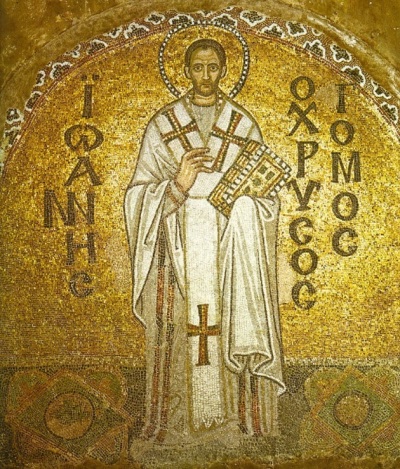How Church Fathers debunked common patriarchal interpretations of the Bible

The Danvers Statement on Biblical Manhood and Womanhood asserts the “husband’s authority” and that “some governing and teaching roles within the church are restricted to men.”
People who believe this, commonly claim to uphold the traditional teaching on gender roles in the Church. But do their interpretations of Bible passages actually convey what church fathers taught? Let’s consider a few examples.
Danvers Statement #3 asserts: “Adam’s headship in marriage was established by God before the Fall, and was not a result of sin.” John Chrysostom, however, writing from AD 386–407, affirms that Eve “was not subjected as soon as she was made; nor, when He brought her to the man, did either she hear any such things from God, nor did the man say any such word to her: he said indeed that she was ‘bone of his bone, and flesh of his flesh’ (Gen. ii, 23); but of rule or subjection, he nowhere made mention unto her” (NFPF1 12:150–51).
Similarly, gender hierarchists typically either give Junia (Romans 16:7) a sex change or deny she was an apostle, just “outstanding in the eyes of the apostles.” Chrysostom repudiates both. With one exception, Epiphanius, who is not credible since he also identifies Prisca as a man, every record of every church leader who commented on Junia during the first millennium of the church treats her as an outstanding woman apostle.
Likewise, gender hierarchists typically put Ephesians 5:22 in a separate paragraph from 5:21 even though they are in the same sentence in Greek. To make the sentence make sense, they add the verb “submit” even though the earliest manuscripts, P46 and Codex Vaticanus, do not include “submit,” nor do its citations by Clement of Alexandria (Stromata 4.8.64), Origen, and Theodore of Mopsuestia.
Jerome writes that in Greek manuscripts, verse 22 never repeats the verb “submit” from verse 21. Virtually all editions of theGreek New Testament omit “submit”: NA, UBS, Nestle, Westcott-Hort, Tasker, Souter, Alford, Tischendorf. The inclusion of “submit” in The Greek New Testament Produced at Tyndale House Cambridge is inconsistent with its aim “to present the New Testament books in the earliest form in which they are well attested” (p. vii).
The United Bible Societies’ text ranks the omission of “submit” as “almost certain.” Gender hierarchists conceal that Ephesians 5:22 depends on its verb “submitting to one another” in 5:21. Paul’s longest passage about marriage, 1 Corinthians 7, especially 7:4, also explicitly teaches mutual submission.
Similarly, advocates of male headship say “head” in 1 Corinthians 11:3 means “person with authority over.” But Cyril of Alexandria, Theodore of Mopsuestia, Athanasius, Cosmas Indicopleustes, Eusebius, Photius, Chrysostom, Theodoret, Theophylact, Ambrosiaster, and Bishop Basil repudiate this interpretation. Cyril of Alexandria (who died in AD 444) in de recta fide ad Arcadiam et Marinam 1.1.5.5(2).63, like many others, explains that “head” means “source”: “Luke [3:28, ‘Adam from God’] . . . explains the source of man, the Creator God. Thus we say that ‘the head (kephalē) of every man is Christ,’ for man was made through him and brought into existence. . . . ‘And the head (kephalē) of woman is the man,’ because she was taken out of his flesh and so indeed has him as her source. Similarly, ‘the head (kephalē) of Christ is God,’ because He is from Him according to nature: for the Word was begotten out of God the Father.”
Gender hierarchists also explain 1 Timothy 2:12 as two prohibitions, but Origen explains it as a single prohibition: “woman not becoming a ruler over man in speaking” (JTS 10, 1909, 42).
Similarly, translations of 1 Timothy 2:15, such as the ESV state, “she will be saved through childbearing.” This verse, however, has no grammatically feminine subject. “Anyone” is more likely implied in light of this sentence’s “if they [plural] abide in faith and love and holiness.”
“The Childbirth” in this context most naturally refers to Christ’s birth and affirms Genesis 3:15’s prediction of the incarnation. Theophylact identifies “the childbirth” (teknogonia) with “the birth of God” and Cramer refers to “she shall be saved” through the one born through her, the Christ.
Like other Church Fathers, Ignatius, circa AD 110, identifies the birth of Jesus as “the childbirth” (ho toketos) in Ephesians 19:1. It was commonplace among the church fathers to compare the fall through Eve to the coming of the Savior through Mary, including Justin Martyr (circa AD 153) Dialogue with Trypho 100, Tertullian (circa AD 160–220) de carne, 41.17, and Irenaeus, Adversus haereses 3.22.4 (circa AD 175–195).
Most gender hierarchists think that 1 Timothy 3:2’s “man of one woman” requires that overseers be male. Church fathers, however, interpret this verse not as a requirement for all, but to exclude either polygamists, as John Chrysostom does, or those who are sexually unfaithful, as Bishop Theodore (died 428) does. “Man of one woman” does not require that all overseers be married men or that they all be men. Even Thomas Schreiner (JBMW Spring 2010, 35) and Doug Moo (TJ 2 NS 1981, 211), who are prominent advocates of male headship, acknowledge that “man of one woman” does not exclude women from the office of overseer.
Some gender hierarchists translate 1 Timothy 3:11, “wives of deacons.” But almost all ancient interpreters state that verse 11 identifies women in that church office. Canon 19 of The Council of Nicaea states of righteous deaconesses: “Let these women receive the laying on of hands by the bishop of the Catholic church.” John Chrysostom’s Homily 11 on 1 Timothy 3 confirms this: “He speaks of those having the office of deacon . . . women deacons.” So do Theodoret 3.656, Theodore of Mopsuestia 2.128, the third-century Didascalia apostolorum 3.12, Oecumenius, and Grotius.
Most advocates of male headship say that “men of one woman” in 1 Timothy 3:12 cannot apply to women. John Chrysostom’s Homily 11 on 1 Timothy 3, however, states regarding this idiom, “‘Deacons must be men of one woman.’ This is appropriate to say regarding women deacons also.”
These examples demonstrate that the common claim from gender-hierarchist interpreters —that the church has always taught their interpretations of these passages — are simply false. In fact, some gender-hierarchist interpretations are completely novel with no support whatsoever from historic Christian interpretation.
For example, W. Klein (ATR 44, 1962, 8) was apparently the first to propose the dominant gender-hierarchist interpretation that 1 Corinthians 14:34–35 prohibits only judging prophecies. By their interpretation, verse 34 permits all speech except judging prophesies. Consequently, verse 34 permits what verse 35 prohibits(!), namely “asking questions out of a desire to learn.”
We have seen that church fathers’ interpretations contradict gender hierarchists’ usual Bible translations and interpretations of these passages. Why does this matter? They understood Hellenistic Greek far better than anyone alive today.
Tragically, most church fathers teach “woman’s inferiority,” including Chrysostom (NPNF112:151.4), and so deny affirmation #1 of the Danvers Statement, that men and women are “equal before God as persons.” Thankfully, unlike gender hierarchists today, many church fathers honestly explained the true egalitarian messages of these texts, even though these egalitarian messages contradicted their culturally-entrenched androcentrism.
May their insightful fidelity to Scripture guide Bible translators and interpreters today.
Philip B. Payne (Ph.D. The University of Cambridge) has taught New Testament in colleges of the University of Cambridge and has been a Visiting Professor of New Testament at Trinity Evangelical Theological Seminary, Gordon-Conwell Theological Seminary, Bethel Seminary, and Fuller Theological Seminary. He is well known for seminal articles on the parables of Jesus, women in the teachings of Paul, textual criticism, and Codex Vaticanus. His books include Man and Woman, One in Christ: An Exegetical and Theological Study of Paul’s Letters, Why Can’t Women Do That? Breaking Down the Reasons Churches Put Men in Charge, and (forthcoming April 4, 2023) The Bible vs. Biblical Womanhood: How God’s Word Consistently Affirms Gender Equality. He founded Linguist’s Software, which provides fonts and input systems for over 2600 languages, including the fonts used to publish the Nestle-Aland Novum Testamentum Graece 28th edition, the UBS The Greek New Testament, and HALOT (The Hebrew and Aramaic Lexicon of the Old Testament). He and his wife Nancy were missionaries in Japan. Their three children and six grandchildren all love the Lord.



























